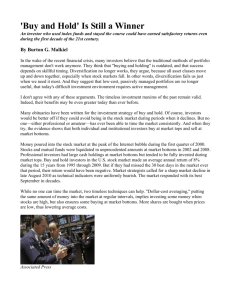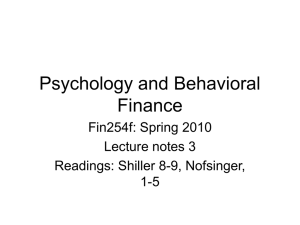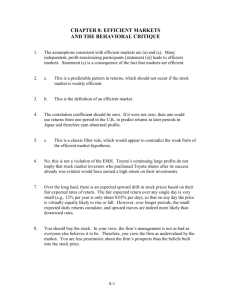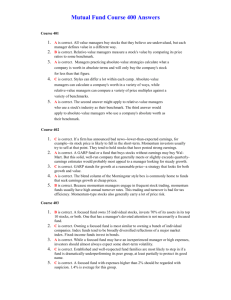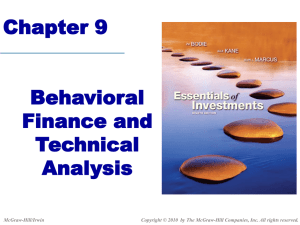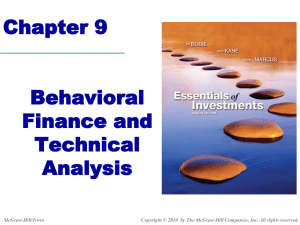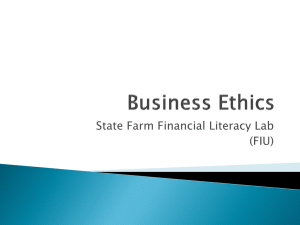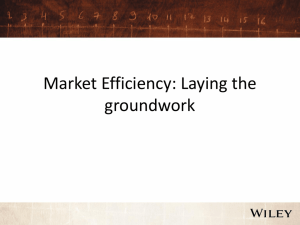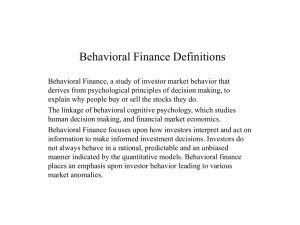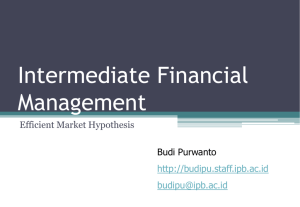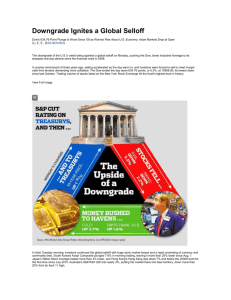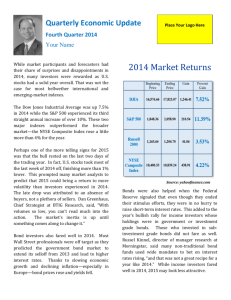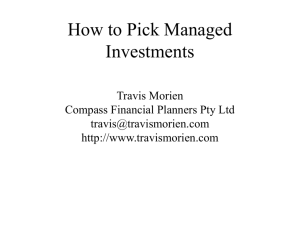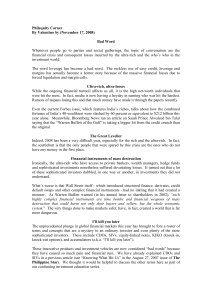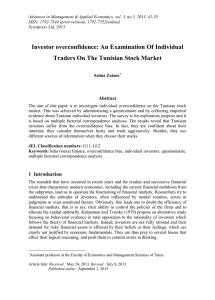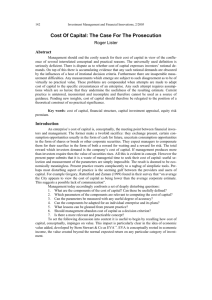PPT
advertisement
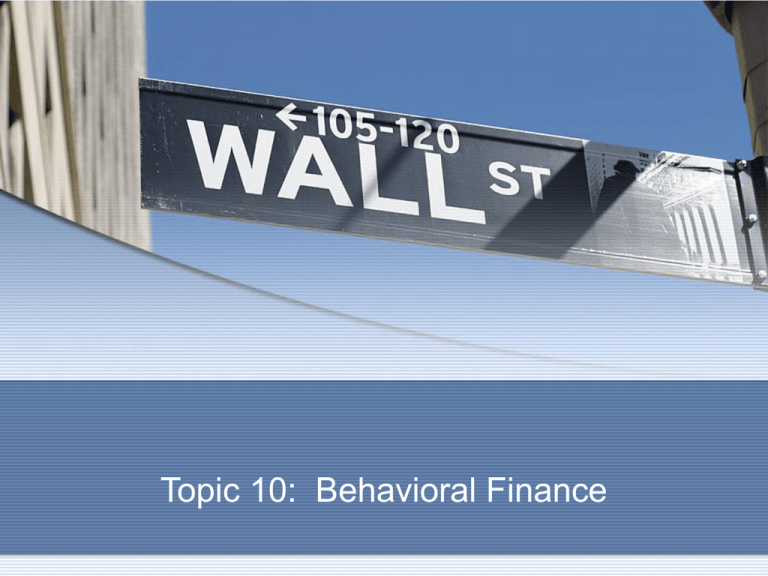
Topic 10: Behavioral Finance Traditional Finance Markowitz, Fama and the rest of the boys Rational decisions and unbiased predictions Risk, return, covariance Semi strong market efficiency and portfolio theory M&M (1961) – assumes investors “always prefer more wealth to less and are indifferent as to whether a given increment to their wealth takes the form of cash payments or an increase in the market value of their holdings of shares” What do we observe? Should be low trading – low volume? Trade on info – low volatility? Growth/Value or Small/Large shouldn’t matter? Dividends shouldn’t matter Equity premium of 7% is too high for risk Momentum shouldn’t exist Positive news boosts depressed stocks more than “up” stocks IPOs underperform long term Addition to S&P 500 permanently increases $ Buffett is just a chance happening What’s going on in the “real” world? “Buy on the rumor, sell on the fact.” “Buy the dips, sell the rallies” “Cut losses short, let profits run” “When in doubt, stay out” “Manage the risks and profits will take care of themselves” “The more certain the crowd is, the surer it is to be wrong” Behavioralism Along come Kahneman, Thaler, Schliefer, Odean, and pals in the 1990s Kahneman had right idea in the 1970s Risk → Fear Return → Greed “Bounded rationality” – event is too complex → biases in heuristics Not always rational and can make predictable errors What’s the diff? Information = Investors’ food which determines activity and prices Noise trading – uncorrelated with changes in fundmental/intrinsic value. EM – prices integrate all info quickly BF – some info neglected and other exaggerated EM – just that, noise! – nothing in aggregate BF – may be biased See other differences play out in slides that follow Behavioralism It’s 1896 and the “Dow” is at 40. It’s 1998 and the “Dow” is at 9181 What would it have been if dividends had been reinvested?? 652,230 – like folding the paper 100 times “Heuristics” enable dealing with many inputs “anchoring” – take 9181 and add some Kahneman & Tversky (1979) – Prospect Theory (psychology) Shleifer and Vishny (1997) – limits to Arbitrage Prospect Theory 2 1 3 Prospect Theory Normal Distribution The probability that yearly return will fall within +/one std. dev. (20%)Is 68% Shleifer and Vishny (1997) Limits to Arbitrage Econ’s Law of One Price Finance assumes riskless and available arb Limits Fundamental risk – arb fear price is right Noise trader risk - Siamese twin stocks Margin calls – Long Term Capital No good substitute to short or may be unshortable A lot of investors are precluded from it and still others don’t want the risk Closed-End funds = individual investors Palm/3com More evidence Liquidity from on-line trading makes arb easier? IPO underpricing? Mergers & Acquistitons are quite frequently bad – overconfidence Lowest decile of stocks based on B/M earn less than risk free rate Dividends shouldn’t matter?? Indicators & Influences 1) Overconfidence 2) Pride/Regret 3) Past history = Info? 4) Mental Accounting 5) Portfolio construction 6) Representativeness 7) Herding 8) Emotions 9) Self Control #1 - Overconfidence A little knowledge is a dangerous thing Survey of 3000 new small business owners 2001 survey of individual investors Excessive trading Excessive risk taking Portfolio losses Stock market return next twelve months = 10.3% Return on personal portfolio = 11.7 Success reinforces overconfidence, so more pronounced in bull markets “Biased self-attribution” #2 – Pride/Regret Pride → “Disposition effect” = reluctance to realize losses Remember prospect theory Sell winners too soon Ride the losers for too long Reference point Need not be purchase price Regret if sell below previous high #3 – Past History = Info? Buy high and sell low – Sounds like a winner to me? More willing to take higher risk after gains than losses Gains → “house money” → overconfidence → seek riskier Losses → “snake bite” → avoid good opportunities Big losses → really in a hole → try to break even “Cognitive dissonance” – seek to reduce pain with selective memory “Confirmation bias” – side with opinions that support own perceptions #4 – Mental Accounting Each decision, action, and outcome filed in separate folder Ignore time value of money “Sunk cost” effect – with anchoring and reference points Covariance & portfolio theory – even finance professors can’t walk the walk Hold losers too long Sell winners too soon No consideration of interaction. #5 – Portfolio construction Covariance and diversification hard b/c of mental accounting Decisions made at individual stock level Accumulate money → What’s a good buy → consider acquisition in isolation 401–K plans Pensions funds, too #6 – Representativeness History again and familiarity ≈ Stereotypes Mary is quiet, studious, and concerned with social issues. While an undergraduate at Berkeley, she majored in English literature and environmental studies. Given this information, indicate which of the following three cases is most probable? a) b) c) Mary is a Librarian Mary is a Librarian and a member of the Sierra Club Mary works in the banking industry Confuse good company for good investment = why value outperforms growth Winner chasing in mutual funds Ivo Welch studied 226 Fin professors Believe in mean reversion and historical trends #6 – Representativeness cont’d Given two risky options, will pick more familiar – “home bias” Breakup of AT&T in 1984 – ownership is regionally concentrated Coke – 16% Georgia owned and most in Atlanta Money managers – most buys are 100 miles closer to manager’s office than typical Pensions invested in firm stock, Enron “Conservatism” is flip-side – New evidence → beliefs don’t change as much as should #7 – Herding 1989 – 32% American own stock 1998 – 50% = investing is more a part of our lives Since is social and need a heuristic → herding Germany fund ↑ 100% at fall of wall ATT to purchase Tele-Communications, Inc eToys grew to $8 B, but Toys r Us only $6 B Dotcom name changes 1998-99 #8 – Emotions We are in a new era. _______ has ushered in a new type of economy. Those stuck in the old ways will quickly fall away. Traditional valuation techniques do not capture the value of this revolution. 1630 – tulip bulbs 1850 – railroad 1920s – Federal Reserve or radio 1950s – New deal 1990 – Biotech 1998 – Internet Other emotions #9 – Self control Understand your biases Know why you are investing = set goals Establish Quantitative investment criteria Diversify if you con’t have time, discipline, skill… Review portfolio annually, but don’t check prices hourly If this sounds familiar, it should Firm Managers are people, too! Psychology may be even more important for firms than investors Assume managers will act in self-interest, but are susceptible to same biases Limited number of managers → greater impact of biases Recent study of mutual fund managers Two ways to look at it (probably truth somewhere in between) Smart managers and dumb markets Smart markets and dumb managers Smart managers and dumb markets Take advantage of investors (rational manager) IPO clusters or issue equity when overvalued CEOs judged on longer time frame than stocks – Managers can “spin” one bad quarter Set dividend policy – catering viewpoint = investors may interpret as a good sign Change name of firm to “dotcom” – investors fall for it Earnings management Sticky dividends Smart markets and dumb managers IPO underpricing Sunk cost good money after bad or hubris-based acquisitions “Bounded rationality” – less than 10% of firms use NPV (payback period is common) Optimism and over confidence All CEOs are above average Capital budgeting projects may be overvalued Too much cash leads to bad decisions Biased self attribution – success is skill and failure is bad luck MYTH = Behavioral Finance is a formula to beat the market NO!!!!! If it is so easy, why ain’t you rich? Market price and fundamental value may temporarily part company A number of academics are walkin’ the walk David Dreman manages $8 B by taking positions contrary to what efficiency would recommend LSV – momentum plays Fuller & Thaler – provide strategies to institutionals “Analysts are slow to recognize the information associated with a major earnings surprise. They are overconfidently anchored to their prior view of the company’s prospects. They underweight evidence that disconfirms their prior views and overweight confirming evidence. They interpret a permanent change as if it were temporary.” Buy on Rumor, Sell on news What lies behind this? Perceived risk vs. reward – utility High probability of small to large reward or very low proability of very large reward – nonnormal distribution Minimal dissemination of information about the event’s risk Delivery of the reward leads to neutral state Thaler/Benartzi’s “Save More Tomorrow” (see WSJ handout) What lies behind this change to 401-Ks? 1) 2) 3) 4) Investor savings low at firms that only offer defined contribution plans Determining how much to save is hard (bounded rationality) Savings for retirement requires self control (willpower) Procrastination – postpone unpleasant (Status quo bias) Saving more = lower standard of living (Loss aversion) What’s it mean for you? Be aware of predispositions Know your competition (Incorporate their actions into your plans) Understand how managers at a firm you are interested in might perform
